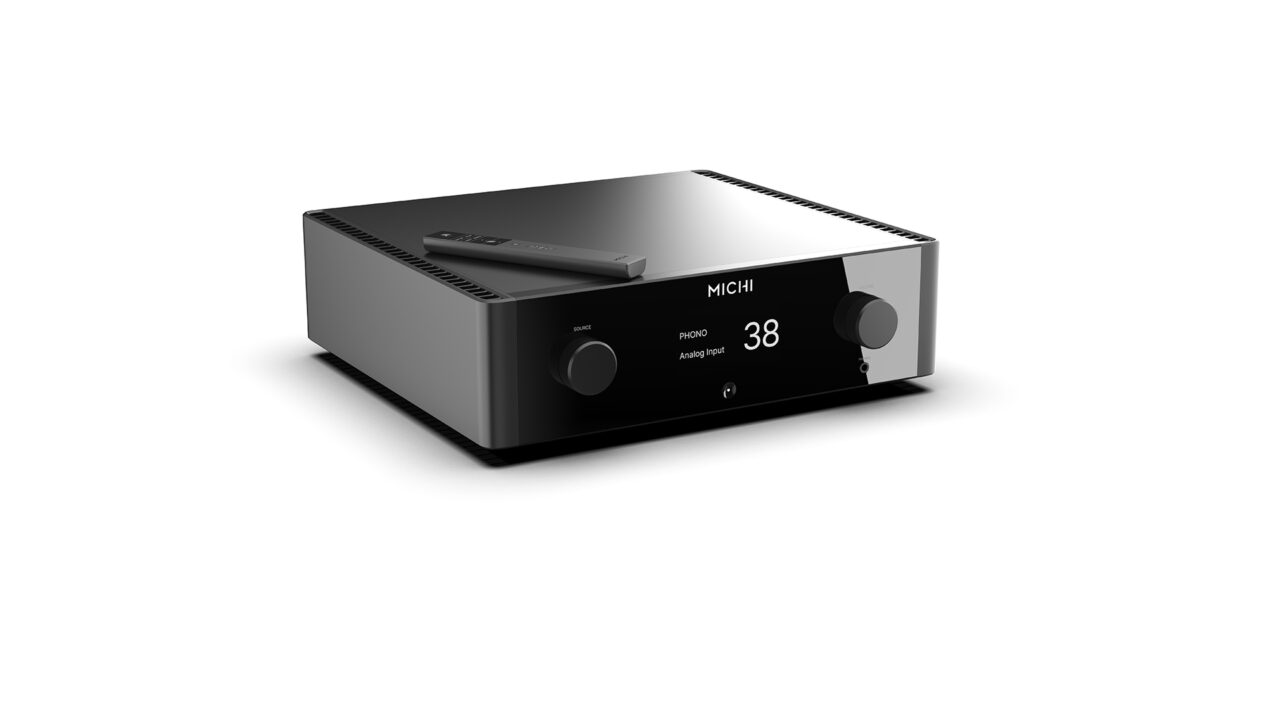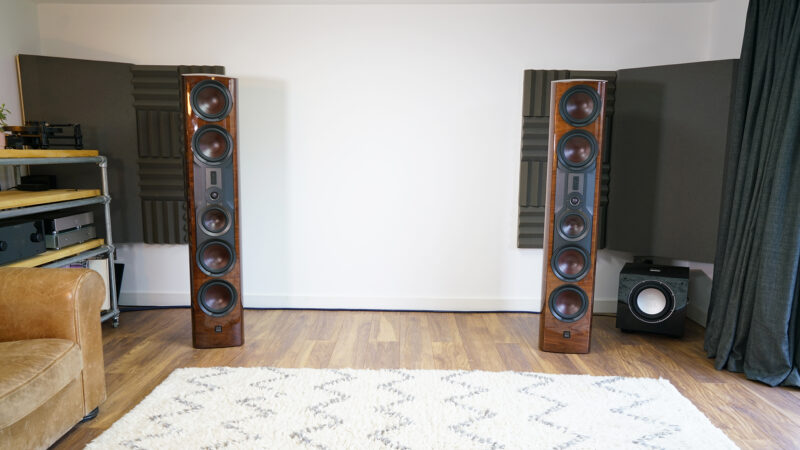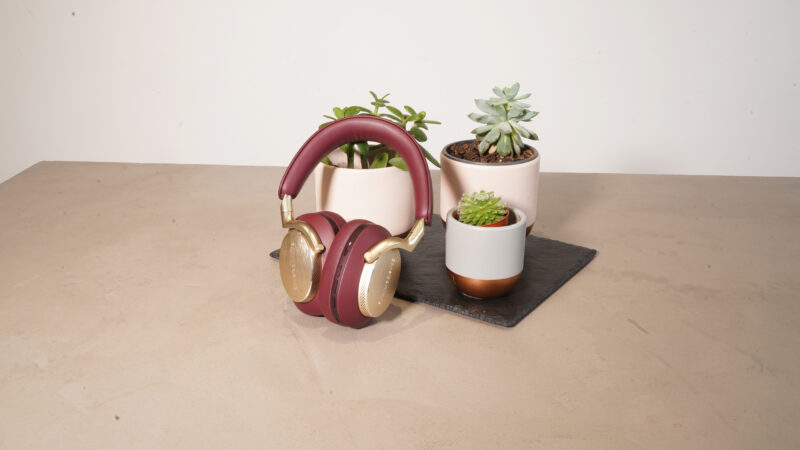When Rotel announced the return of its flagship Michi series a few years back, it did more than just revive a higher end range with higher end price tags – it reminded the world just how capable Rotel is in going toe to toe with hifi’s elite.
The original Michi range hit the market around the 30 years ago, and immediately raised Rotel’s bar for no compromise audio gear, gaining such a reputation that these models are still highly prized today.
This latest range not only builds on these past products, but surpasses them by some way. In fact the Michi name is so well respected, Rotel has eschewed adding its own brand name to each model’s front panel, simply adorning them ‘Michi’.
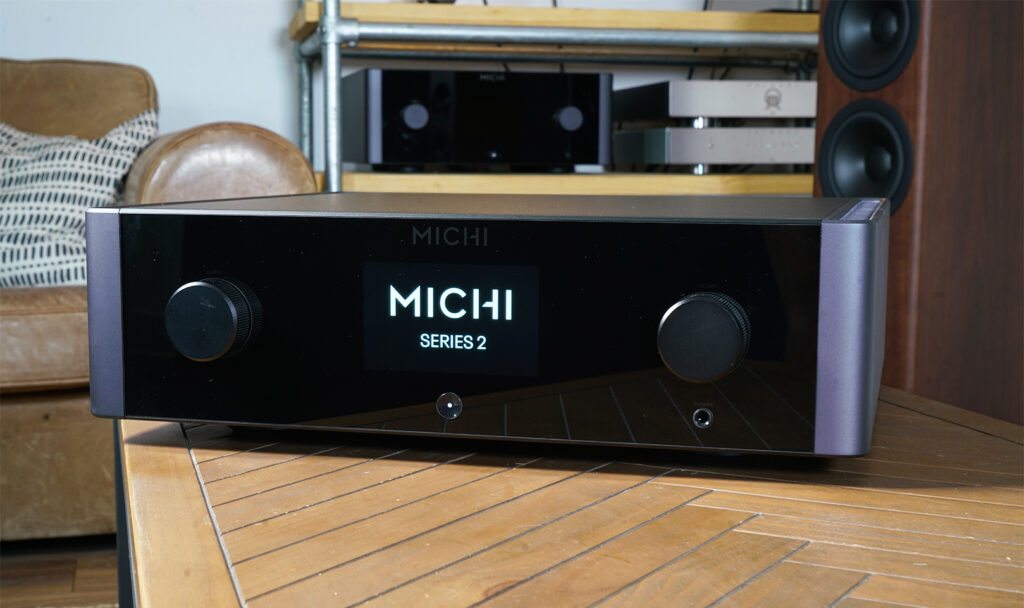
Michi X3 Series 2 taking up residence at Audiograde HQ. Twin left and right rotary dials are for source selection and volume control, while the central push button takes it out of standby mode to get its musical juices flowing
I got the power
For context and for those less familiar with Rotel’s history, it’s a company that builds hifi kit that lasts. My first amp was a vintage Rotel RA-611 in the early ’90s, and by then it was already as old as me (and better looking), handed down from my dad. That amp is still going strong today, which is testament to its internals and the quality of its power supply in particular. Why is this relevant to this review? Because Rotel has been making its own power supplies for decades, upon which its reputation for quality, durability and finesse is built.
While current Rotel amps pay some visual homage to those models past, this new Michi is a very different beast in its thoroughly modern sleek black steel and glass fronted livery. And while looking identical to the previous X3 integrated, inside it packs a range of component upgrades, (96, since you’re asking) justifying its MK2 status and increased price tag from £4,300 to £5,999. It’s still the cheapest of two integrated models in the Michi range, sitting under the X5 Series 2 which now comes in at £8,199, with separate pre, power and monobloc amps also on offer. Not only is the X3 S2 cheaper than the X5 S2, it’s also shorter at 150mm vs 185mm and almost 15kg lighter, making it a little easier to manage in real life settings. The main reason for the sleeker size is due to a smaller PSU, with single rather than dual toroidal transformers.
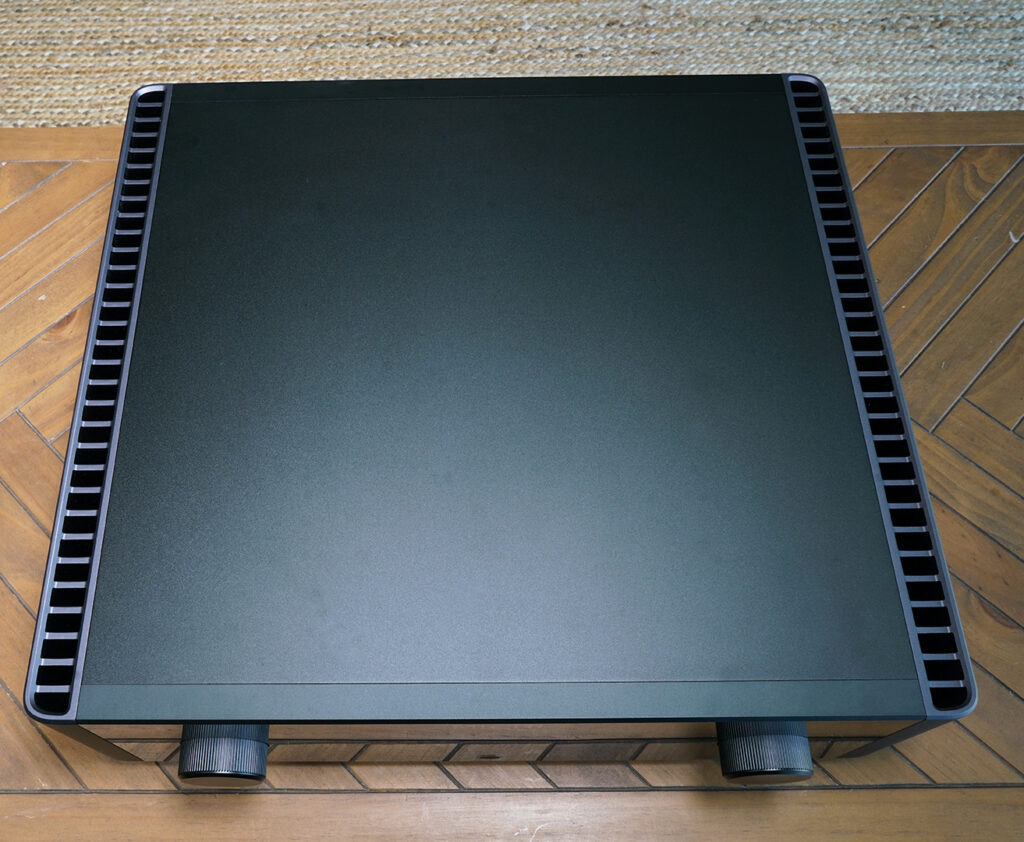
Left and right grilles double up as heatsinks, helping to account for the X3 S2’s 29kg heft
While £6k might seem quite a chunk of cash for an integrated amp, what Rotel has managed to deliver at this price is quite something – so much so you’d be paying a lot more if this was built by rival brands that don’t have the production scale Rotel can call upon.
Spec wise it gets a well thought out spread of analogue and digital inputs. For the former this means three sets of line-level RCAs, plus a dedicated single-ended moving-magnet turntable input, alongside a set of balanced XLR sockets. By comparison this is only two less inputs than its X5 S2 bigger brother (which also gets a moving-coil input), although personally I’d welcome more balanced inputs on both at this price.
The digital side is perhaps where things get more tantilising, thanks to a new ESS Sabre eight-channel 32-bit/768kHz ES9028PRO DAC, in place of the previous AKM chip. Add to this improvements in the X3’s digital input switching and clock circuits and it’s clear where Rotel’s technicians have been hard at work. The DAC is accessed via three optical and three coaxial S/PDIF inputs catering for files up to 24-bit/192kHz, plus a USB-B input for PCM data up to 32-bit/384kHz and DSD up to 256 with quad-DSD up to 11.2MHz. And there’s more, as demonstrating its fully modern status means it also gets aptX HD Bluetooth connectivity and support for MQA (including Studio) alongside being officially Roon tested.
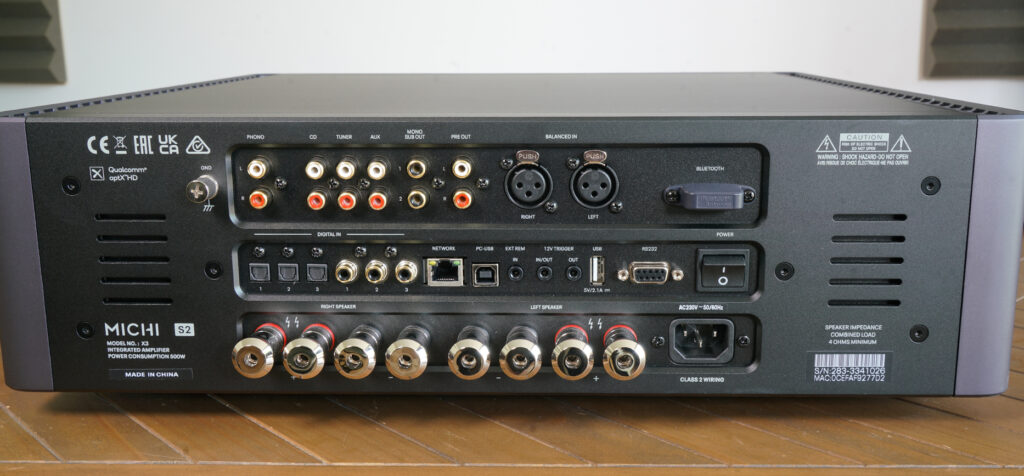
Rear socketry is well organised with analogue connections at the top (including XLR and MM inputs), digital on the middle row (with Ethernet for software updates) and speaker output terminals on the bottom row
There’s also a handy USB-A socket for powering external devices, alongside twin subwoofer and preamp outputs, should you want to add another power amp and dedicated subs.
Last but not least for many will be the inclusion of a front panel 6.35mm headphone socket, which adds yet more versatility and underlines the X3 S2’s genuine integrated nature.
Lifting its lid and the view that greets you is that of an amplifier manufacturer of serious pedigree, which starts with a massive 625KV-A custom built high current screened toroidal transformer, feeding a bank of four high-efficiency, low ESR slit-foil bulk storage smoothing capacitors, totalling 60,000uF (15,000uF each). Output devices are ten pairs (five per channel) of Rotel’s in-house measured and matched 180V Sanken 2SA1492-OPY / 2SC3856-OPY bipolar high current variants (compared to a dozen pairs of 260V Sanken MN1526-OY / MP1526-OY for the X5 S2). In power terms this means that the X3 S2 offers 200W of Class AB wallop into 8 ohms, increasing to 350W into 4 ohms (vs the X5 S2 which churns out 350W/8 ohms and 600W/4 ohms).
The X3 S2’s left and right power amp boards are stacked vertically against each cheek’s heatsink which are slickly incorporated into the casework, while DAC and preamp boards are stacked above each other, backing on to their corresponding inputs to keep signal paths short.
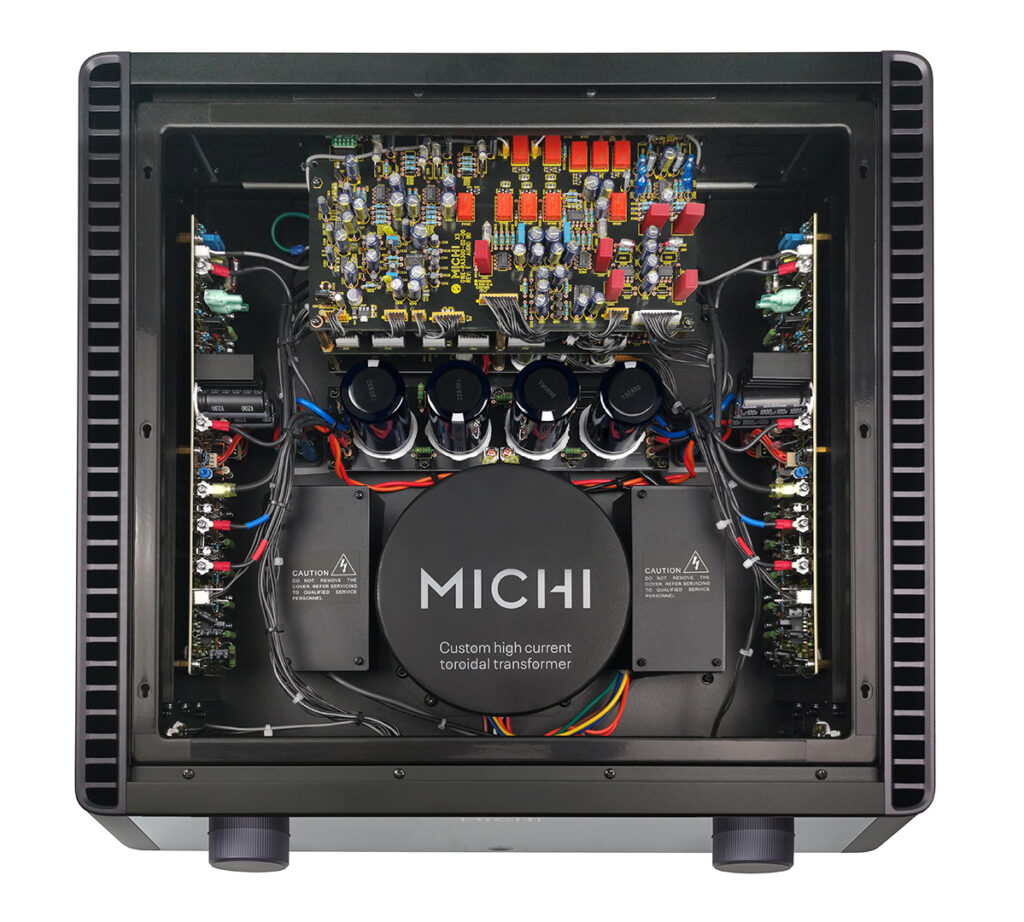
The Michi X3 Series 2’s internals are a sight to behold, with power supply bottom of shot, smoothing caps midway, power amps stacked vertically left and right against the heatsinks, plus preamp and DAC boards top of shot
Smooth operator
Of course an amp at this level’s feature set is only as good as its usability, and this is where the Michi X3 S2 really excels. Only when you gun up the front panel screen do you briefly know you’re in Series 2 territory, as there’s no printed reference to its model name or number on this – or any of the Michi range’s front panels – which makes for a much cleaner and consistent look that flies in the face of the usual hifi front panel clutter with model names longer than your arm. For the smartscreen age, the Michi’s understated design language is bang on trend.
With the left rotary dial selecting source and the right one operating volume control, the supplied slender metal remote is there for a deeper dive into menu settings. Options include naming sources and disabling them when not in use (saving you scrolling through empty inputs), alongside display options for volume shown as large numerics, funky digital VU meters or a range of spectrum analysers. Elsewhere tone controls (bass/treble or direct bypass) for individual inputs plus L-R balance, Auto Power Off, a child lock feature (to prevent any unwanted speaker melting mistakes) and software updates makes for a sophisticated yet practical mix of real world functionality, combined with nice to haves. And while all these options may sound complex, the Michi is so intuitive to use I didn’t need to open the user manual once.
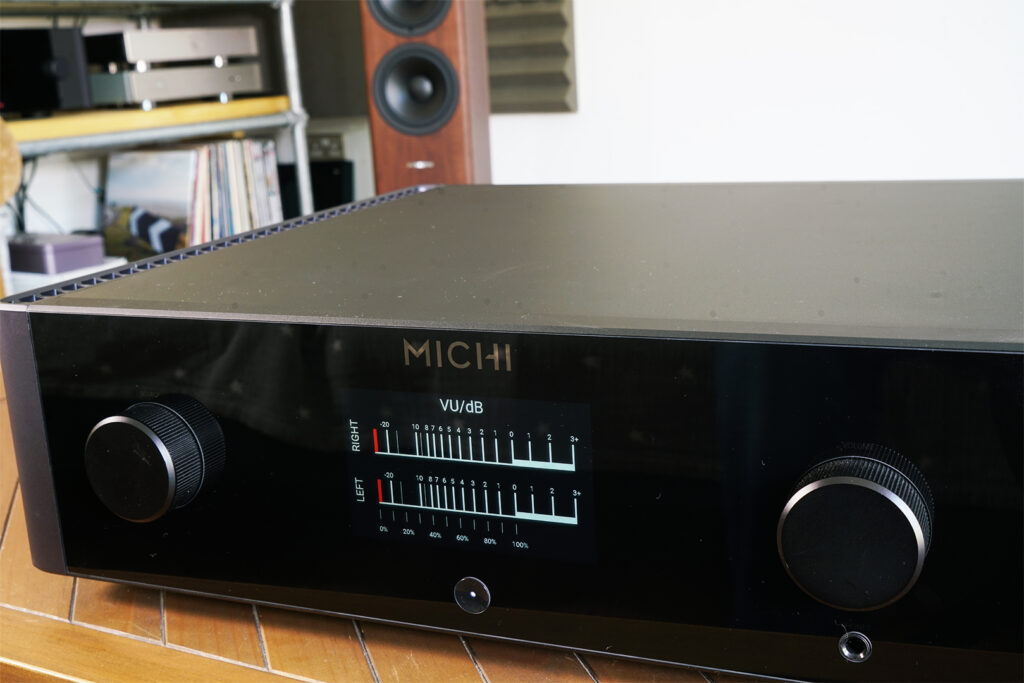
Customisable front panel screen includes old school digital VU meters
Unboxing the amp reveals how precisely made and finely finished this amp is. It’s pure class in an understated way and at almost 30kg, it’s also clear Rotel hasn’t scrimped on the casework, from its rounded and chamfered sides to its platinum-plated speaker binding posts it feels luxurious, but not in a way that will date or scream for attention.
Performance
Kicking off with Jordan Rekei’s excellent new release The Loop on vinyl (firstly via the Michi’s moving-magnet input and then via its XLRs fed from an SME 20/2 turntable with AVID Nexus tonearm, MoFi MasterTracker cartridge and Primare R35 phono stage) and it’s more than smile inducing to hear that none of the previous X3’s analogue character has been lost. That sense of punchy dynamics and effortless power with depth and detail to match has all been thankfully retained. I’ve lost count of how many times I’ve been presented with MK2 models from other brands that are full of enhancements and promise, only to find the original’s character has been sacrificed along the way. What Rotel has managed with the X3 Series 2 though is adding improvements only where they’ve deemed them necessary, and leaving the good bits well alone.

Michi series’s slender remote is a cut above average, forged from alloy rather than plastic
If this was an analogue only integrated amp it would still be a worthy contender against similarly priced rivals, then add in the upgraded digital side circuitry and the Series 2 really starts to stand out as class leading.
Truth teller
Streaming the 2014 remaster of Red Hot Chill Peppers’ I Could Have Lied at 24-bit/96kHz via Qobuz from a Primare NP5 Prisma Mk2 over a coaxial connection reveals the added finesse Rotel as sprinkled on the X3 S2’s digital internals. Drums and percussion are delivered with reassuring levels of impact via my Dynaudio Evoke 50 loudspeakers in a way few amps have managed in my 30sqm listening space, while the lead guitar towards the end of the song has that bit more natural attack and bite compared to the 1st gen’s DAC.
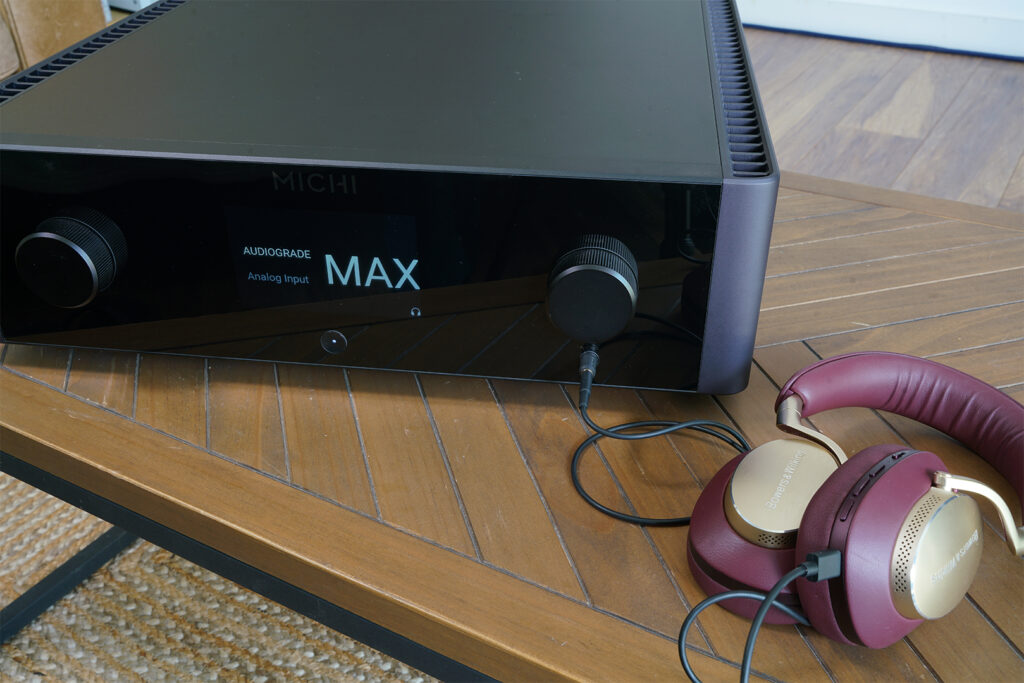
6.35mm headphone output is a handy addition and easy to use, as inserting it auto-mutes the speakers (denoted by the headphone icon on the screen)
What this underlines is that the X3 S2 is an amp that can do many things: Oodles of power to deliver rock with piledriving force and realism? No problem, as Soundgarden’s Spoonman at 24-bit/192kHz easily attests. Subtle delicacy and nuance all at once to lure you in? With ease. Bess Atwell’s latest album Light Sleeper at 16-bit/44kHz sounds so smooth it’s almost impossible not to get lost in repeat listens. And the icing on its sonic cake is grand scale productions, because recordings demanding uncompromising levels of instrument separation, soundstage depth and width are where the X3 S2 is really at home – all of which makes it a hi-end amp you could genuinely live with day to day, wanting for little else.
Sibling rivalry
Having had a series one Michi X5 integrated at the heart of my reference system for some time (chosen for its sophisticated un-fatiguing delivery and ability to drive virtually any speaker), pitching this back to back with X3 Series 2 makes for intriguing results.
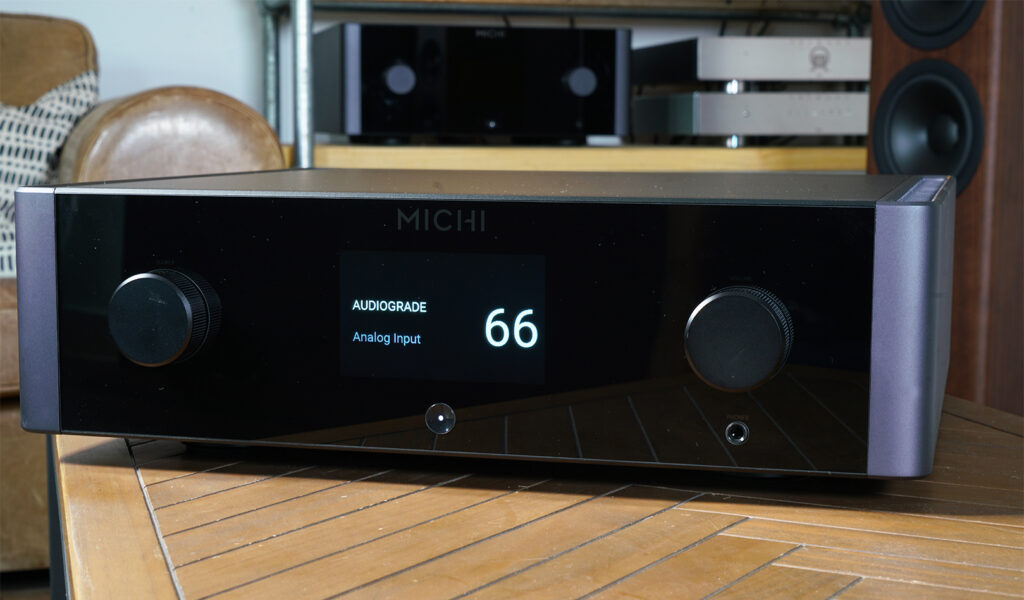
X3 Series 2 under the watchful gaze of its older X5 bigger brother, with both offering similar sonic recipes
What the X5 excels at is serious scale, even more so than the X3 S2, denoted by its thicker, denser textures within the fabric of the musical picture it paints. And yet in comparison the older X5 seems a little shyer than the X3 S2 in coming forward, but what it’s actually doing is imparting even less of its character on the music than the X3 S2 (and the X3 S2 imparts very little), while at the extremes, the X5’s bass is a little darker with a slightly less forward midrange which is instead a little more expansive width ways and layered. It’s also more powerful, meaning less turns on the volume dial – but let’s be clear here that neither is lacking in this respect, its just that while the X3 S2 has enough grunt to pull the proverbial house down, the X5 sounds like it could take next door with it.
Ultimately in comparing both, you’re hearing what sounds like a different measure of ingredients applied to a similar underlying dish, and if the X3 S2 was served up for dinner it would be Michelin (or should that be Michi) starred.
In summary
If Rotel’s mission was to upset the hi-end apple cart with the Michi range then not only did they do this, they shook the whole orchard. So impressive is the Michi range’s build and performance that with a US or Swiss name on their front panel we’d likely be seeing an extra zero on their price tags.
And the X3 Series 2 is arguably the bargain of the bunch, giving relatively little away to it’s bigger X5 brother. With style, lashings of power, detail and dynamics its sets the standard at this price, making it highly recommended.


